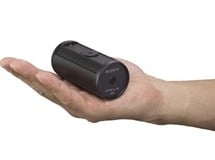PERFORMANCE is the key to Sony’s SNC-CH210 HD and this camera doesn’t disappoint. The SNC-CH210 offers 30fps at 1080p HD resolution. At the heart of this performance is Sony’s 3MP (2048×1536 pixel) Exmor CMOS sensor which provides excellent pictures and event detection for effective evidence gathering. Derived from Sony’s broadcast product range, Exmor is one of the highest quality image sensors available, with low noise characteristics for improved image acquisition. The sensor employs progressive acquisition (as opposed to interlace) and this means that images are more stable to view, contain more information and compress more efficiently without interlace artefacts. The camera’s Triple Codec Network Operation means there’s support for three compression formats: JPEG, the best choice of high-quality still images; MPEG-4, the format that provides clear moving images efficiently over limited-bandwidth networks; and H.264, the alternative for severely limited-bandwidth networks, providing twice the efficiency of MPEG-4. The camera can also generate multiple streams simultaneously.Another neat function of SNC-CH210 is the Stream Squared feature which allows simultaneous streaming of two 4:3 aspect ratio videos in user-selectable SD resolutions. You simply select the entire image or a portion of the image from the original view and resize to SD resolution. With this feature the SNC-CH210 can replace two SD cameras installed in the same line of view and allows end users to stream a wide angle view and a close-up shot at the same time – ideal for keeping a close eye on trouble spots and keeping the wider picture in sight. Also useful is Sony’s Intelligent Motion Detection The SNC-CH210’s built-in IMD function can trigger a variety of actions, such as the storage and transfer of images or the activation of an external device through its output relays. False alarms caused by noise and repeated motion patterns are minimized thanks to an advanced Sony algorithm. When the camera is used in conjunction with DEPA-enabled recorders or software, a multitude of filter functions are available. These allow users to initiate alarms based on more specific movements, such as passing a virtual borderline.DEPA is a combined function of the intelligence built into the camera and software rules or filters that determine which images should be recorded or when an alarm should be triggered. Using the network camera Intelligent Motion Detection (IMD) function, tagged objects and their associated metadata, including object position, are sent either to the NSR Series recorder or the IMZRS400 Series software. These products then use the metadata, together with filters, to analyze object movement and to perform a predefined action, such as image recording or alarm triggering. This method of distributed processing minimizes server workload, network bandwidth, and storage requirements. The NC-CH210 camera has Power over Ethernet (PoE) capability allowing the same Ethernet cable used for data transfer to handle power. This feature greatly reduces the physical infrastructure costs and speed of deployment. Sony uses an ONVIF protocol for the exchange of information between network video devices, including automatic device discovery and video streaming and interoperability between network video devices.Other features include discreet size of just 44mm x 93mm, operating temperature from -20 to 60C, electronic shutter, white balance mode, gain control and auto exposure. Meanwhile, Protocols supported include IPv4, IPv6, TCP, UDP, ARP, ICMP, IGMP, HTTP, HTTPS, FTP (client/server), SMTP, DHCP, DNS,NTP, RTP/RTCP, RTSP, SNMP (MIB-2) and ONVIF.
36.7
C
Sydney
19.8
C
Canberra
32
C
Darwin
17.9
C
Hobart
26.3
C
Perth
29.4
C
Brisbane
19.4
C
Auckland
16.5
C
Melbourne
- Advertisement -








